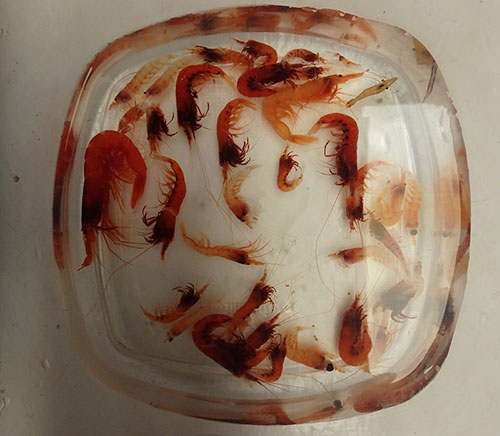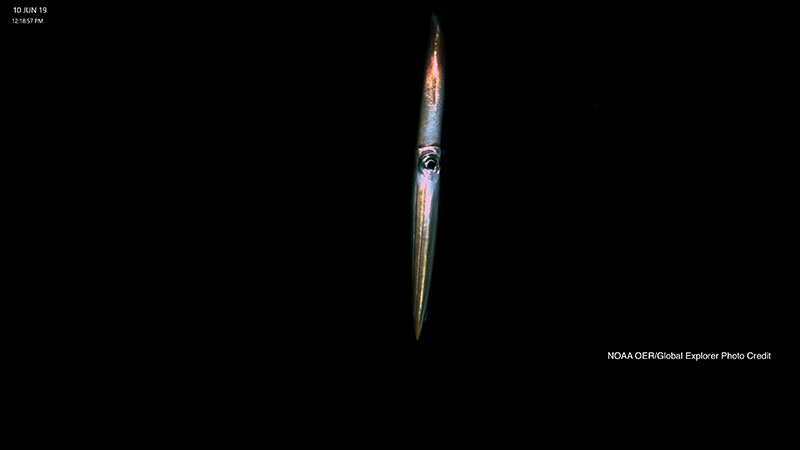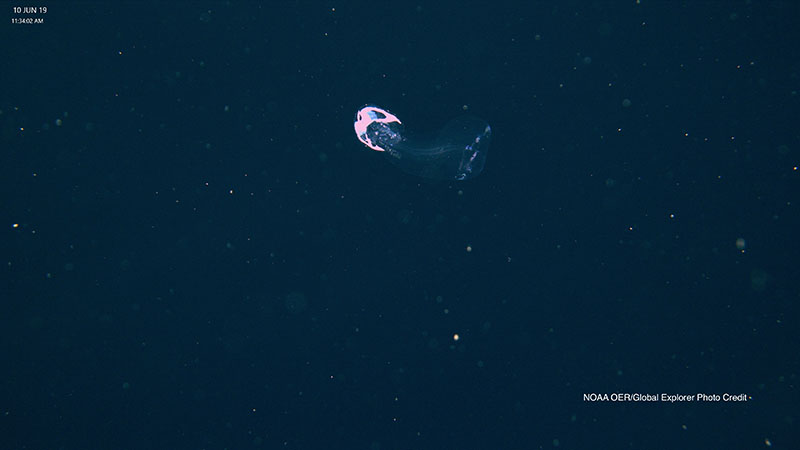
By Tracey Sutton, Ph.D., Associate Professor, Department of Marine and Environmental Sciences - Nova Southeastern University
June 10, 2019

Figure 1: Scientists and boat crew getting the trawl ready for deployment. Image courtesy of Journey into Midnight: Light and Life Below the Twilight Zone. Download larger version (jpg, 5.3 MB).
As soon as the squalls ended and the rough seas quieted, we were all anxious to start doing what we are here to do - science! Finally at 22:00 hours last night (June 9), we deployed the Tucker Trawl for our first tow. It was all hands on deck to get the equipment for the net and the sampling mechanism set up to be hoisted by the A-frame (large structure in the shape of an A that aids in the lifting of the heavy equipment) on the stern of the ship. Once it was in the water, the winch released the cable to get the net approximately 200-300 meters (656-984 feet) in the water column to allow capture of the organisms on their nightly vertical migration travel upward that we are targeting. The trawl was pulled for approximately three hours behind the ship and then collected. After the large Tucker Trawl net (Figure 1) was brought on board and the sample quickly sorted, approximately 13 species of fish and 10 species of crustaceans were collected (Figure 2).

Figure 2: Dish of crustaceans collected in the first tow of the Tucker Trawl. Image courtesy of Journey into Midnight: Light and Life Below the Twilight Zone. Download larger version (jpg, 3.5 MB).
The good weather continued for us this morning and we were able to continue with doing our science work! At about 0700, the Oceaneering crew assembled and gave us a thorough safety briefing about how best to deploy the remotely operated vehicle (ROV). The ROV weighs approximately 7,500 pounds. so in the words of our chief scientist, Dr. Sonkë Johnsen, it is the equivalent of lifting a multimillion dollar “Cadillac off the deck of the ship” by a crane and trying to set it in the water on a ship rocking with the seas while avoiding injury to anyone or any of the equipment/ship. It involves an enormous amount of teamwork and expertise that was truly phenomenal (and bringing it back in has the same challenges, just in reverse order!).
We started running transects (patterns that are likened to “mowing the lawn” back and forth horizontally in the water column) to use the 4K video (incredibly high-definition video used for digital cinema) cameras to collect information about the animals we can see in the bathypelagic/ midnight zone of our study project. We started at 1,000 meters (3,280 feet) and ran a transect for 15 minutes at that depth and then dropped a 100 meters (328 feet) every 15 minutes with 15 minutes in between the transects to be able to descend.
The ROV pilot/control center is every gamer’s dream job! Getting paid to use a joystick control to drive a robot that searches for things in the water. I say this lightly because the job is super cool with several 4K video screens in a control room, but it is not that easy! I know firsthand because I have driven very small ROVs with our students that compete in the MATE Project in a pool and it is extremely difficult and these Oceaneering pilots have the added stress of extremely expensive equipment at deepwater depths where many things can go wrong! This took several hours, but we got some amazing images of some organisms in their natural habitat (Figures 3-4).

Figure 3. Awesome squid at 1,100 meters (3,610 feet). NOAA OER/Global Explorer. Download larger version (jpg, 310 KB).

Figure 4. Free-swimming larvacean (we saw many larvacean houses, which in the words of Dr. Tracey Sutton, are the “mucus polysaccharide structures that are spun similarly to that of a spider by the larvacean intricately to provide them with food.”) NOAA OER/Global Explorer. Download larger version (jpg, 5.0 MB).